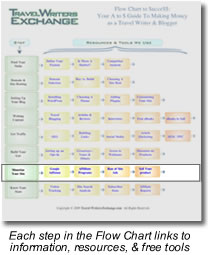If you’re wondering what this Case Study is all about, please read the introductory post from Week One.
Last week we started digging into methods that Suzy can implement to earn some revenue from her travel blog, beginning with adding Google AdSense.
This week it’s all about Affiliate Programs – those ads that travel bloggers like Suzy hope will entice you to buy something, because it earns the blogger a small amount of money. Small, yes, but with enough site traffic, it can add up if done correctly.
Judging by the ads I see on nearly every website I visit, chances are good that you’re already pretty savvy when it comes to Affiliate Programs, but for those who aren’t I’ll explain briefly what they are.
 Affiliate Programs are basically where you – the travel blogger – promote some product or service and include a link that, if clicked on and the product or service is purchased, earns you some revenue. You are the “affiliate” (also often referred to at the ‘publisher’ since you publish the ads to your site).
Affiliate Programs are basically where you – the travel blogger – promote some product or service and include a link that, if clicked on and the product or service is purchased, earns you some revenue. You are the “affiliate” (also often referred to at the ‘publisher’ since you publish the ads to your site).
This is a “cost per action” model (CPA), meaning that you earn revenue when some action is taken, such as making a purchase or signing up for mailing list (yes some websites do pay if you help them increase subscribers). Google AdSense is a “cost per click” model (CPC), meaning that you get paid when someone clicks on the links.
You can promote the products or services passively, with graphic (image) ads in your banner or sidebar, or actively through your content, such as a review or endorsement of the product or service that includes text links.
Affiliate Programs are dominated by the Big Three – Commission Junction, LinkShare, and Google Affiliate Network, which are basically “aggregators” that act as middlemen and escrow agents between the advertisers and affiliates (there’s also ClickBank, far and away the largest but they deal only with ebooks). In addition there are many dozens of smaller programs (e-junkie and ShareASale are two notable ones), and many Advertisers (merchants) run their own affiliate programs without using an aggregator.
It’s free to set up an account with any of the Affiliate Programs, and you can belong to as many of them as you like. Likewise, you can display as many ads on your site as you like, but the key to success with affiliates ads is relevancy.
I cannot stress enough that word enough. I have a framed sign hanging over my desk that has on it just these words: “Is it relevant?”
Is what you are writing about relevant to your travel niche? Are the keywords you’re focused on relevant to your topic? Are your inbound (and outbound) links from (and to) relevant sites? Are your social media marketing efforts staying “on message” and relevant to your expertise? Are the products and services you choose to promote relevant to your travel niche and thus to your audience?
Relevancy is the key to successful affiliate advertising also. If your ads don’t speak to the reason people are at your site, it’s unlikely that they’ll inspire clicks.
A few tips for successful affiliate advertising
- Do I really need to say it? Choose ads to display only from relevant advertisers;
- Put some thought into what you really think your readers will like;
- ONLY choose high quality products, and only those you believe in, otherwise your credibility will suffer;
- Positioning is critical – if you bury your ads no one will see them, let alone click on them. Ads get more clicks if they are placed in your 1) banner, 2) upper right of your sidebar, and 3) above the fold (in that order);
- Use your real estate wisely – does that single large skyscraper ad really produce as much as 8 or 10 smaller square ads in your sidebar? You’ll know if you’re tracking and testing;
- Test, Test, Test – you won’t know what works and what doesn’t if you’re not trying new things;
- Avoid too many animated or rotating ads – a couple may attract the eye, too many repel site visitors;
- Make use of the Affiliate Managers and support team at each affiliate network you use – it’s their JOB to help you succeed and they KNOW their business well;
- Don’t hesitate to study the top people in your niche to see what THEY are doing – who’s ads are they displaying?
There are many WordPress Plugins and Widgets for managing ad placement, and a number of Themes that also have custom ad placement spaces in their design. If you have questions please post them in our Forum for Affiliate Programs so we can address your specific blog setup.
Stay tuned! Next week we’ll discuss how Suzy is also using another advertising model, Direct Advertising agreements.
~Trisha
Are you using Affiliate Ads on your travel blog? Share your experience!






I put ads on my blogs, but haven’t made any money from them. The ads are relevant to my blogs. Not sure what to do. Maybe my keywords need to be tweaked or my writing :)
Hi Rebecca! Remember, it’s all about the traffic (volume) – if you’re comfortable that your ads are really relevant to your target audience, then focus your efforts on increasing traffic to your site.
This is similar to the old snail-mail marketing – advertisers would send out many thousands of mailers, because the typical response rate was somewhere around 1% – 3%. It’s the same with online marketing – you have to have thousands of visitors to your site, because only a small percentage will actually respond to your ads. But with enough visitors, that small percentage can equal a decent income for you.
Sweet info, Trisha! Bookmarking this post.
.-= Candice´s last blog ..Mouth stitched shut, brain wide open =-.
We have had bad luck with commission junction. I think that we didn’t test enough. We put up the ads and never thought of them again. We thought, “hey, we believe in the Lonely Planet, we use Skype, I am sure that others are going to follow our advice.” But we didn’t place them in any particular order, move them around to see what worked or send people to the companies.
We are doing better now by using less ads and putting up larger ads too. But I think that you are absolutely right, volume is the key. As we have started to build followers, we are also getting more clicks on our ads.
It may have been as simple as we just didn’t have the readership yet when we first put up our CJ ads.
Thanks for the information, this is such a useful series.
.-= Dave and Deb´s last blog post: We Are Back in the Travel Saddle Baby =-.
Yep, you hit the nail on the head – it’s all about the traffic. Also, when you have time Commission Junction does have their own tutorial called “CJU” to help bloggers get the most from their ads.
I’m glad you’re enjoying this series – we have another fun installment coming up this week!